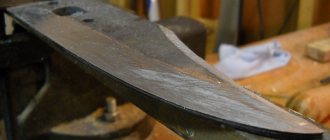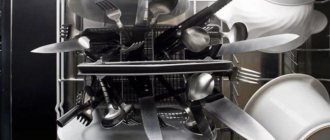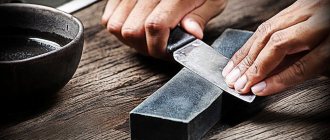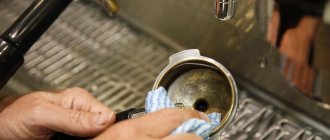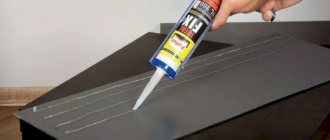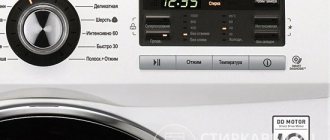Knife sharpening is a classic skill for brutal action heroes who need to keep their blade sharp and deadly at all times. In our case, the ability to sharpen a knife will be useful, rather, to properly cut cheese and sausage for a delicious sandwich. That’s why it’s time to tell you how to properly sharpen knives with a whetstone by hand, so as not to fall into despair when at some point your tool cannot cope with a loaf of bread.
It is also useful for hunters and collectors of bladed weapons to know how to sharpen a knife. In everyday life, they more often than others resort to using blades, which are their passion or a tool for cutting up innocent animals.
Be that as it may, today there are many devices for sharpening knives, which include complex electrical appliances, Japanese water stones, ordinary ceramic dishes and, of course, the good old whetstone.
If you've never tried sharpening a knife, don't be surprised that you might not be very good at it the first time. Here, as in any matter, skill and practice are required.
How do you know when it's time to sharpen your knife?
Every knife, even if it is made of first-class metal with maximum strength, may one day have a dull blade. To understand that it needs to be refreshed, you need to do a basic check. For example, using the following three methods.
- Take a hemp rope, fold it four times and try to cut it with a knife. If everything worked out, then the blade does not need sharpening yet. If the rope remains intact, it’s time to take out the tools.
- If you have a needle file (miniature file) at home, run it along the blade of the knife. If, with strong pressure, the blade scratches the surface, and with weak pressure, it slides, then everything is in order.
- If you have neither rope nor a file, the classic method with paper will come to the rescue. Take a regular A4 sheet, fold it and try to cut it on the fold with a knife. If the blade slides smoothly and without much effort, then the knife does not need to be sharpened. Otherwise, it's time to get down to business.
- Try cutting a tomato. Doesn't it cut and turns into tomato paste? This means your knife has been in need of sharpening for a long time.
A bread slicer for each
Everyone has knives. Regardless of who you are—an experienced nymphomaniac who won’t go out on the street without three blades and a multi-tool, or an inveterate pacifist and non-resistance to violence—you definitely have a knife. If not with you, then at home in the kitchen. Or in the car. Expensive or cheap, warehouse, tourist, hunting, bought from a fashion catalogue, given to a friend “for a penny”, made in the zone or machined at a secret factory from a rocket nozzle - there are countless of them.
Typical “knife in the car just in case”
Three quarters of them are stupid. Sometimes you go with friends to the pampas, you need to cut something, and they’re like: “Oh! I have a knife in my glove compartment!” Something fearful is brought into the light of God, whose wit varies from “dumb as a Siberian felt boot” to “only used to cut up dead mongrels.” And what? They used this to open cans, chop nails on a dare, and pick at bricks. This is how it became. It’s easier for me - I always have a “folding bag” with me, for a quarter of a century now. And it's sharp.
Do you want the same? Learn to sharpen.
How to sharpen a knife at home with a whetstone and other tools
So, let's move directly to the sharpening technology itself, which requires some effort.
First of all, you need to take a whetstone and dip it in oil or water for 15 minutes. This is necessary so that small particles of steel do not accumulate between the grains of the stone, which ultimately leads to the unsuitability of the whetstone.
We will begin sharpening the knife from the coarse-grained side of the block. The most important thing here is to correctly position the blade relative to the surface of the whetstone. The result of our efforts largely depends on this.
Experienced knife sharpeners advise positioning the blade at an angle of 20 degrees to the block. However, this inclination can be changed depending on the type of knife.
- Fillet and chef's knives are sharpened at an angle of 25 degrees;
- Japanese kitchen knives require an inclination of 10-20 degrees;
- Hunting blades and blades are sharpened at an angle of 30-45 degrees;
- Regular kitchen knives require approximately 30 degrees of sharpening;
- Straight razors are sharpened at an angle of 10-15 degrees.
The sharpening angle directly affects the final sharpness of the knife. That is, if you want your blade to be incredibly sharp, you need a sharper angle. However, for greater knife strength and resistance to dulling, it is best to increase the sharpening angle.
The knife must be sharpened with smooth and continuous movements, slightly lifting the handle when the process reaches the bend of the blade. It is also worth remembering that the blade must be guided so that the direction of movement is perpendicular to the cutting edge.
You should also not put too much pressure on the blade, in the hope that it will sharpen better and faster. However, even if the movements are too soft, there will be no effect. Here you need to maintain balance and maintain optimal impulse on the bar.
The blade should be sharpened until a noticeable burr is felt on the back of it. In this case, you need to start sharpening the back side of the blade and reach the stage when the blade is smooth and even.
Types of sharpening stones
Japanese water stones
Sharpening stones come in several varieties: diamond, ceramic, natural, Japanese water. In addition, sharpening devices are also of the electric type. Without the skills to sharpen knives at home, it is better to use a regular abrasive or ceramic whetstone. Electric sharpeners can damage the blade if you lack the necessary skills or have a low-quality tool. In order to straighten the blade, you should use musat.
Other scissors...
Manual and mechanical, of various designs - the knife-loving public has come up with a lot of things, but personally I respect only two varieties.
Firstly, the grinder. This is a belt surface grinding machine that allows you to perform a variety of operations - from sharpening a blade to making a knife (and other useful things made of wood and metal) in general.
Making a grinder with your own hands is especially chic; many topics are devoted to this on specialized forums. With proper practice, sharpening a knife with this device is literally a matter of minutes. I don't have a grinder, but I want one. Of course, there is nowhere to put it... But I still want to.
Secondly, musat. In essence, it is a round (less often semicircular or oval) file with a very fine notch. Musats are made of steel (including diamond-coated) and metal-ceramic.
Despite all its primitiveness, it is the musat that is the primary tool for straightening knives in the kitchen. However, it all depends on practice: in the same way, it is necessary to maintain a constant correct angle in relation to the blade. Whether to steer the blade towards yourself or away from you is your own choice. The main thing is to develop the correct movement.
I almost never use other “sharpeners” and don’t see much point in them. It will be interesting - I'll tell you next time.
Selection of sharpener
At home, you can easily sharpen kitchen blades to the required sharpness quite quickly. To do this, you just need to choose the right sharpening stones.
Options for sharpening stones:
- natural;
- diamond;
- ceramic;
- water Japanese.
To begin with, it is better to purchase several inexpensive whetstones and practice sharpening knives with them for some time. And when you have enough experience, you can purchase a set of expensive Japanese or diamond stones.
Recommendations for purchasing sharpeners:
- The ideal length of the bar is 1.5-2 times the length of the knife blade, but not shorter. The shape and width of the sharpener does not matter.
- There should be no chips on the block. Its surface must be perfectly flat.
- To gain experience in sharpening knives, it is recommended to buy a universal stone of medium hardness or a block, the sides of which have different grain sizes (you can have two separate stones with fine and large grain sizes). Over time, the collection of sharpening products can be replenished.
- It would be nice to get some donkeys that were produced back in the Soviet Union. Such products can be found at flea markets and must be marked “Made in the USSR”. Soviet-made bars are distinguished by high-quality binding material and uniform grains.
- To sharpen a knife to the sharpness of a razor blade, you will need not only sharpening stones, but also a special GOI abrasive paste.
If you have no practice in sharpening knives, it is recommended to purchase an ordinary ceramic stone made in the shape of a boat. It can be purchased at any hardware store. This is an inexpensive product characterized by increased wear resistance and a long service life. The only negative is that such bars wear out unevenly.
Blade options
To sharpen a kitchen knife efficiently, you must not only have a regular whetstone on hand, but also know how to use it. It is also important to know what material the blade is made of in order to choose the right sharpening device for it.
Types of blades by material of manufacture:
- Carbon steel. This budget option for inexpensive products is made from an alloy of iron and carbon. Such blades are very easy to sharpen and retain their sharpness for a long period. The disadvantage of this material is oxidation when interacting with an acidic environment, as a result of which stains and rust form on the blade. Oxidation stops after some time when a coating forms on the metal.
- Stainless low carbon steel. The alloy of this material, in addition to iron and carbon, includes chromium. For some products, molybdenum or nickel is additionally added. In terms of strength, stainless steel blades are inferior to their carbon steel counterparts. They become dull faster and therefore require frequent sharpening. The advantage is high corrosion resistance.
- High carbon steel. These are knives of a higher category. A higher quality material with a high carbon content is used to make the blade. Vanadium or cobalt is additionally added to the alloy. Products made from this metal are resistant to corrosion and do not require frequent sharpening.
- Damascus steel. This material is intended for the production of edged weapons. But there are also models of kitchen knives. Such products have a multi-layer blade made from several high-quality alloys. The only negative is the high cost of the product.
- Ceramics. Blades made from this material are famous for their sharpness, which they retain for quite a long time. Due to this quality, they are very popular among consumers. But there is also a big disadvantage of such products - the high fragility of the material. The ceramic blade can be damaged by dropping the product on the floor from a height, or by significant bending.
When buying knives, it is not recommended to be fooled by advertising of self-sharpening products. Blades made of absolutely any material become dull; only those made of high-quality alloy last longer and, accordingly, cost more.
But you shouldn’t spend a lot of money on buying expensive blades; it’s better to buy a set of ordinary kitchen knives, several high-quality sharpening devices and learn how to sharpen knives yourself with a whetstone.
Sharpening and editing
First, let's separate these two concepts. Sharpening is the formation of a cutting edge (CR), and editing is needed to bring this edge to working condition. At high magnification, the cutting edge of a knife sharpened on a large block looks, frankly, unimportant and resembles a rock ridge eaten away by erosion.
Editing the paint using a fine abrasive allows you to bring this visual nightmare to a more or less decent state. The knife begins not only to cut, but also to shave (if, of course, you did everything correctly).
Bottom line
You don't have to be a chef to have a good cutting knife in your kitchen. Over time, the blade wears out, which greatly complicates the cooking process and turns it from pleasure into torture. Thanks to sharpening, the properties of the blade are restored.
Previous
Ancient HOK Pugio dagger - weapon of Roman legionnaires
Next
Making knivesKunai: cut and size of knife for throwing
